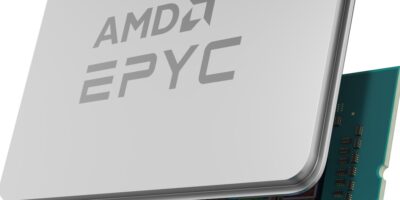AMD implements 3D die stacking for data centre CPU
Claimed to be the world’s first data centre CPU using 3D die stacking, the third generation AMD EPYC processors with AMD 3D V-Cache technology (codenamed Milan-X) has been released. AMD built the CPU family on the Zen 3 core architecture and can deliver up to 66 per cent performance uplift across a variety of targeted technical computing workloads versus comparable, non-stacked third gen AMD EPYC processors, reported the company.
The new processors are also claimed to feature the industry’s largest L3 cache, delivering the same socket, software compatibility and modern security features as third gen EPYC CPUs but with features for technical computing workloads such as computational fluid dynamics (CFD), finite element analysis (FEA), electronic design automation (EDA) and structural analysis, used in testing and validating designs.
“Building upon our momentum in the data centre . . . [third generation] AMD EPYC processors with AMD 3D V-Cache technology . . . offer the industry’s first workload-tailored server processor with 3D die stacking technology,” said Dan McNamara, senior vice president and general manager, Server Business Unit, AMD. “Our latest processors with AMD 3D V-Cache technology provide breakthrough performance for mission-critical technical computing workloads leading to better designed products and faster time to market,” he added.
Technical computing workloads relying heavily on large data sets. These workloads benefit from increased cache size, however 2D chip designs have physical limitations on the amount of cache that can effectively be built on the CPU. AMD 3D V-Cache technology solves these physical challenges by bonding the AMD Zen 3 core to the cache module, increasing the amount of L3 while minimising latency and increasing throughput, according to AMD. This represents a step forward in CPU design and packaging and enables breakthrough performance in targeted technical computing workloads, commented the company.
The third generation AMD EPYC processors with AMD 3D V-Cache technology deliver faster time-to-results on targeted workloads. For example, the 16-core, AMD EPYC 7373X CPU can deliver up to 66 per cent faster simulations on Synopsys VCS, when compared to the EPYC 73F3 CPU.
The 64-core AMD EPYC 7773X processor can deliver, on average, 44 per cent more performance on Altair Radioss simulation applications compared to the competition’s top of stack processor, claimed AMD. In a third comparison, AMD reported the 32-core AMD EPYC 7573X processor can solve an average of 88 per cent more computational flow dynamic (CFD) problems per day than a comparable competitive 32-core count processor, while running Ansys CFX.
These performance capabilities enable customers to deploy fewer servers and reduce power consumption in the data centre, helping to lower total cost of ownership (TCO), reduce carbon footprint and address environmental sustainability goals, said AMD.
The third generation AMD EPYC processors with AMD 3D V-Cache technology are available today from OEM partners, including, Atos, Cisco, Dell Technologies, Gigabyte, HPE, Lenovo, QCT, and Supermicro.
Third generation AMD EPYC processors with AMD 3D V-Cache technology are also broadly supported by AMD software ecosystem partners, including, Altair, Ansys, Cadence, Dassault Systèmes, Siemens, and Synopsys.
Microsoft Azure HBv3 virtual machines (VMs) have now been fully upgraded to third generation AMD EPYC with AMD 3D V-Cache technology.




